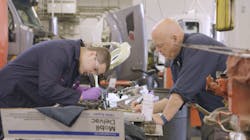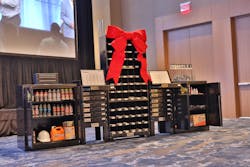Warm welcome, family atmosphere key to successful shop retention efforts
Part 2 of 2. Read Part 1 here.
There are plenty of ways for fleets and shops to mold the raw clay that are automotive trade students into master mechanics. It starts by engaging with the high schools and post-secondary centers. An owner or executive can participate in an advisory board to steer the curriculum. A seasoned tech can swing by the school to provide students with an accurate account of what really happens in the bay. And the maintenance staff can host students at the facility so they can see first-hand what life in the shop is all about.
If executed properly, these strategies will work to get a tech in the door, advised George Arrants, ASE Education Foundation’s vice president, and Paul Cigala, an ExxonMobil commercial vehicle lubricants applications engineer and vice-chair of the TMC S.3 Engine Study Group. The duo hosts a podcast called “The Long Haul with George and Paul” where they and guests discuss these in greater detail.
This gets that newly sculpted entry-level technician through the door, but what happens after? Both Cigala and Arrants explained to Fleet Maintenance that onboarding is just as crucial to keeping a new employee’s interest in the automotive repair trade—and your company— high enough to make a career and a life there.
Arrants claimed too far often these lumps of clay are treated like pieces of meat: “thrown to the wolves” and “left to die,” he described.
Patience is a far better practice, according to Arrants, a former auto tech educator.
“Don't expect them to be productive right away,” he advised. “Don't look at entry-level technicians as an expense; look at them as an investment in your company. Most companies want instant gratification. They want that seasoned tech, and let's be honest, any seasoned tech worth their salt is not out on the market looking for a job.”
In other words, if you want skilled technicians at your shop, you need to season your own fresh meat.
“Why hire somebody with bad habits when you can hire somebody with no habits?” Arrants asked rhetorically. “The only bad habits they learn are the ones you teach them.”
Arrants also noted it costs between $7,500 and $9,000 on average to onboard a new technician.
“Wouldn't it be better to take that money that you're constantly using to find new people, and maybe invest some of that in your current people, so they don't go somewhere else?”
Arrants asserted that one mutually beneficial tactic is to increase pay based on certifications earned.
“That's a carrot: get a certification, make more money. Get another certification; make more money,” Arrants said. “That's short-term. They don’t have to wait five years to do this.”
He said fleet and shops of all sizes can practice this approach of investing in retention efforts to combat labor issues, and the so-called technician shortage many maintenance providers rail on about.
“Those companies that have taken that approach, we don't hear from them,” Arrants noted.
Arrants said in technical school and community colleges alone, they are churning out about 11,000 graduates a year.
“The interest has been there; I just don't think the transition from education to industry has been as seamless as it could be,” Arrants said. “If we start to fix those problems, some of these massive shortage concern starts to relieve themselves.”
Family matters
All of this starts with a warm welcome and friendly environment. Most of these recent grads starting out at their first shop fall into the category of Gen Z, born from about 1997 to 2012. They don’t remember the world before 9/11 or cell phones but have plenty of experience with terrorism, endless wars, and recessions. Basically, they have seen some stuff and want to spend their time on things they value.
See also: Understanding Gen Z could be key to unlocking staff shortages
“My generation, we live to work; this generation works to live and maybe they got it right,” Arrants said. “And some of our [older] folks need to understand there needs to be that work-life balance.”
Part of this is making work feel more like home.
“Really focus on making sure that the technicians coming out of schools are prepared to get into the industry and are onboarded correctly,” Cigala advised. “If he doesn't feel part of the family—maybe struggling and nobody’s helping him or watching over his shoulder—he’ll be gone in less than a year on to something else.”
This means less time critiquing what they didn’t learn in school and muttering “what do they even teach you nowadays,” and more on handing down the tribal knowledge and instilling nuggets of wisdom a mentor likely passed on to you.
Cigala said simply explaining the basics in greater detail can go a long way: “Understanding when they get an oil analysis report back, where some of those contaminants are coming from, and where to make a repair, that’s huge.”
Arrants agreed that “onboarding them into that shop culture” and making them feel that all-too-rare esprit de corps is crucial.
“Some employers forget that if you're with your technicians eight or nine hours a day, they spend more time with you than anybody else in their life—and if they can't feel like they're part of a family or group, they're going to go somewhere else to get that feeling,” Arrants offered.
A final thing Arrants said to remember is that “the family makeup when [Baby Boomers] were kids is completely different than family makeup today,” so by providing that feeling of family, you could be offering something far more valuable to that employee than a steady paycheck—you could be giving them a sense of belonging.
The ones that got away
ASE survey data indicated that after graduation from high schools and trade school, 20% drop out of the trade right away and another 21% within the first two years of their newfound career.
“Now through the surveys, we've done when they leave, they don't leave trades using their hands—they just don't stay with us,” Arrants said. “They're onto construction, or HVAC or, or something else—wind energy is a big one.”
And all that time your team spent working on curriculum at local schools and mentoring students just blows away.
“We trained them, we got them excited, and then we took the wind out of their sail, and they went somewhere else,” Arrants said.
ASE surveys also found the number one root cause for new technicians jumping ship.
“The number one reason that anybody leaves is the boss,” Arrants said. “When an employee leaves your company, what they're saying to you is: ‘the unknown is better than staying with you.’ And people don't like to hear that, but it's the truth.”
Part of being a good boss is first, finding a good mentor for that new tech—someone assigned to watch over their shoulder. And this mentor is likely not the one billing the most hours or knowing the most about electrical troubleshooting.
“It's not your best technician in the shop,” Cigala said of the best mentors. “Usually, it’s the technician who has been there for a while, knows the ins and outs, and can work closely with that new technician to help them.”
Competitive nature
“It's something for the technician to compete in and really show how good they are,” Cigala said. “And some of the prizes they give away at SuperTech are just unbelievable. Between the tools and money and trips, it's just fantastic.”
The 2021 grand prize was worht more than $20,000 in tools and other prizes.
Cigala also said some fleets have asked to have “mini” SuperTech competitions set up at their facilities. These team-building exercises also provide data on what areas technicians need help in.
“They thought their technicians were well-trained and knew everything out there until we started grading the tests and found out they don't,” Cigala said of one of these on-location events. “It was very eye-opening for them.”
About the Author

John Hitch
Editor-in-chief, Fleet Maintenance
John Hitch is the award-winning editor-in-chief of Fleet Maintenance, where his mission is to provide maintenance leaders and technicians with the the latest information on tools, strategies, and best practices to keep their fleets' commercial vehicles moving.
He is based out of Cleveland, Ohio, and has worked in the B2B journalism space for more than a decade. Hitch was previously senior editor for FleetOwner and before that was technology editor for IndustryWeek and and managing editor of New Equipment Digest.
Hitch graduated from Kent State University and was editor of the student magazine The Burr in 2009.
The former sonar technician served honorably aboard the fast-attack submarine USS Oklahoma City (SSN-723), where he participated in counter-drug ops, an under-ice expedition, and other missions he's not allowed to talk about for several more decades.

